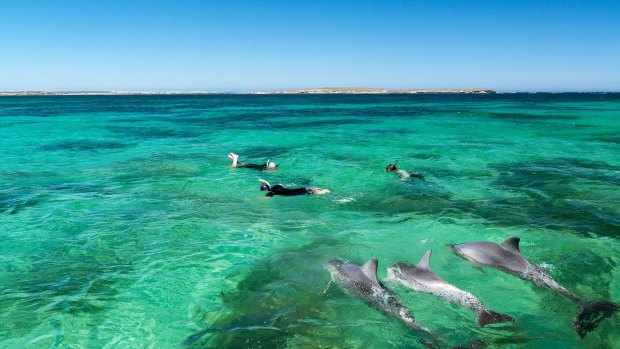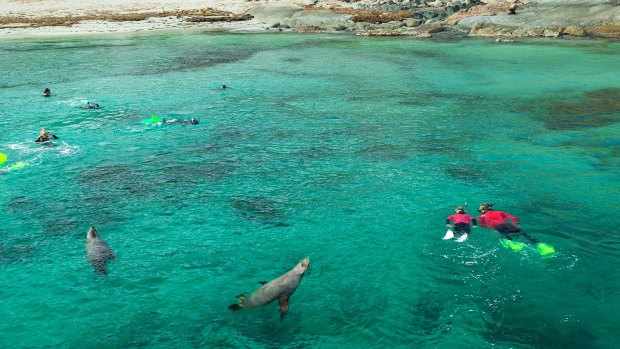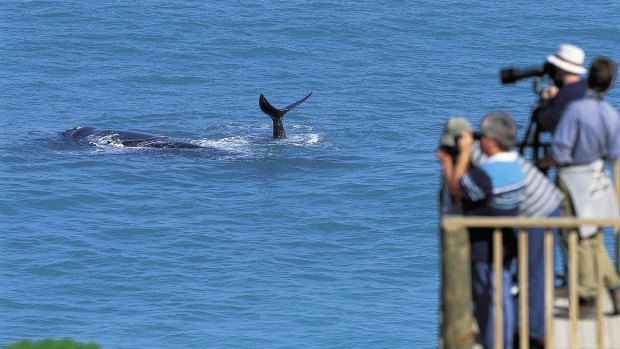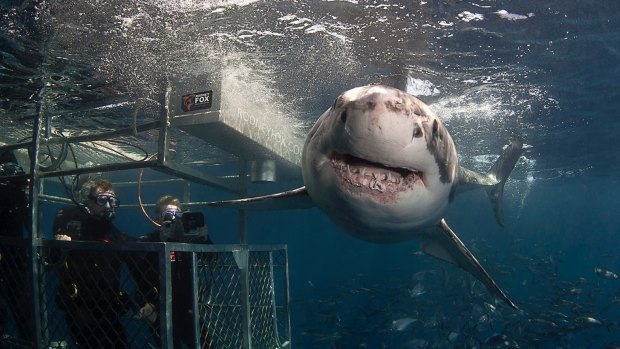This was published 8 years ago
Eyre Peninsula’s sharks will leave you breathless
By Max Anderson

The local pod - swimming with dolphins at Baird Bay.Credit: John Montesi
SPONSORED ARTICLE
There's no question that Eyre Peninsula gets a lot of its reputation as an edgy wilderness destination thanks to some of the biggest great white sharks on the planet.
Many of the region's 59,000 human residents, including 14,000 in the capital Port Lincoln, are employed in the fishing industry and have a story on this, the most revered and feared apex predator.

Swimming with seal lions at Seal Cove.Credit: Rob Blackburn
But the fascination doesn't stop at Lincoln: in 2014 some 15,000 visitors went to South Australia's adventure capital to go face-to-face with animals that are longer than a family SUV.
The region is bigger than Nepal, and harbours some extraordinary natural habitats – from the ancient Gawler Ranges to the remote cliffs and beaches that line 2000km of improbably wild coast.
But we'll stick with sharks, since that's what people are now coming to see, travelling from as far as London, New York and Moscow.

This is serious whale country.Credit: Milton Wordley
You can cage dive with great whites in South Africa, New Zealand and Mexico, but for the combination of superb water visibility, low numbers of boat operators and quality of operation, Port Lincoln continues to be the most highly regarded.
There are three companies running shark diving operations out of Lincoln, using large, modern boats to host people on trips lasting one to five days.
You don't need a dive licence to submerge, you do however need to be prepared to descend a metre on the end of a regulator (air line) in a steel cage that is subjected to clear, cold and sometimes choppy waters.

Jaws - the Rodney Fox Shark Experience. Credit: Adam Bruzzone
There's a proper expedition feel to the experience since there's no telling where the sharks are at any one time (scientists still don't know where they breed along the Australian coast).
However, the Neptune Islands, 2 ½ hours' sailing out of Lincoln, are a pretty good bet, preferred by the predators for its abundant populations of tasty New Zealand fur seals.
Adventure Bay Charters uses music to attract the sharks and has recently fitted its boat with an excellent viewing pod so six people can sit and watch the underwater action in relative comfort. Boats carry up to 27 divers.
Calypso Star Charters uses berley to attract the sharks and has live-action camera streamed into the boat for non-divers. Boats carry up to 37 divers.
Immersive shark experience
Rodney Fox Shark Expeditions offers a somewhat more immersive shark experience with plenty of natural history expertise on board: the company takes smaller groups on two- to five-day live-aboard trips, offering both surface cage diving and ocean floor cage dives for certified divers.
For the day trips, you'll pay around $400 for the 13-hour day-trips plus an extra $100 if you see sharks. It's claimed there's a two out of three success rate, but if you don't have an encounter, you receive a half-price voucher should you wish to try again.
So what about the less fearsome wildlife?
Closer into shore, bottlenose dolphins are familiar sight. Indeed, it's not difficult to see them, especially on a boat when you're creating a bit of wake.
Coffin Bay has a lively local pod around small rocky isles called The Brothers: they came to national prominence when they were observed in the act of sleeping, which had rarely been seen in the wild – the animal lies on the surface for three or four seconds with one half of its brain shut down.
The most famous dolphins however are probably at Baird Bay, between the towns of Venus Bay and Streaky Bay.
A pod of 30-odd mammals have been observed for over 20 years by Alan and Trish Payne of Baird Bay Ocean Eco Adventures.
Serious whale country
The couple take guests out to snorkel in the calm waters where they're amazed by the animals' size, speed and grace.
Once you've finished with the dolphins, the Paynes will also have you snorkeling with Australian sea lions. Sea lions are as curious of us as we are of them, and if ever there was an excuse to buy yourself some underwater camera gear, this is it.
Adventure Bay Charters and Calypso Star also offer excellent underwater sea lion encounters out of Port Lincoln – the colony is just a short ride from the Marina.
If you've made it as far as Baird Bay you're on the doorstep of some serious whale country. Between late May and early October, humpback and southern right whales migrate into the warm waters along South Australia to calve.
Fowlers Bay is one of their favourite spots for calving, with up to 30 animals taking up residence in the sheltered bay for three months.
The tiny outpost, with spectacular dunes on one side and turquoise waters on the other, is home to a caravan park owned by whale enthusiast and professional diver, Rod Keogh.
Keogh operates a season-long whale watching operation using his first-class dive boat, Asherah.
It's been modified for hosting and fitted with a platform at rear for more intimate whale encounters.
Keogh is licensed to motor within 150m of the animals (one of the closest in the country) and is currently applying for licence to permit guests to swim with Humpback whales.
Iridescent hues
Close to the West Australian Border is the Marine Park Whale Sanctuary on Bunda Cliffs at Head of Bight .
Small group coach tours run from Ceduna out to the Sanctuary viewing platform where up to 100 whales can be seen.
Winter is also the season for one of the strangest wildlife stories to come out of Eyre. Between May and August, up to 200,000 Giant Cuttlefish swarm – aggregate – just meters off the beaches between False Bay and Fitzgerald Bay on the east coast.
If you can brave the cold water (Diving Tours in the town of Whyalla will hire wetsuit mask and snorkel) you can wade out to watch the male cuttlefish try all sorts of strategies to catch a female.
The most impressive of these is flushing their bodies with colour in a strobing effect.
It's seen nowhere else in the world and to date is the preserve of locals and (rather excited) scientists. Alas, in 2013-14 the aggregation practically disappeared, but numbers are returning for 2016.
Eyre is famous for its marine animals, but this substantial piece of country also offers first class inland encounters with Australian land animals.
The Gawler Ranges in the north are 1.5 billion years old, and some 120,000 acres have been declared National Park.
Pioneer terrain
The country is a remote mix of low hills, salt lakes, ancient river beds and pastoral lands farmed by people who really did it tough.
Unsurprisingly, populations of kangaroos, wallabies and emus easily dwarf the few human visitors who make it into this beguiling region.
There's camping in the park, shearers' quarters options on far-flung stations and super-luxury tents in the highly-regarded Kangaluna Camp.
This article is brought to you by South Austrlian Tourism Commission
Sign up for the Traveller Deals newsletter
Get exclusive travel deals delivered straight to your inbox. Sign up now.